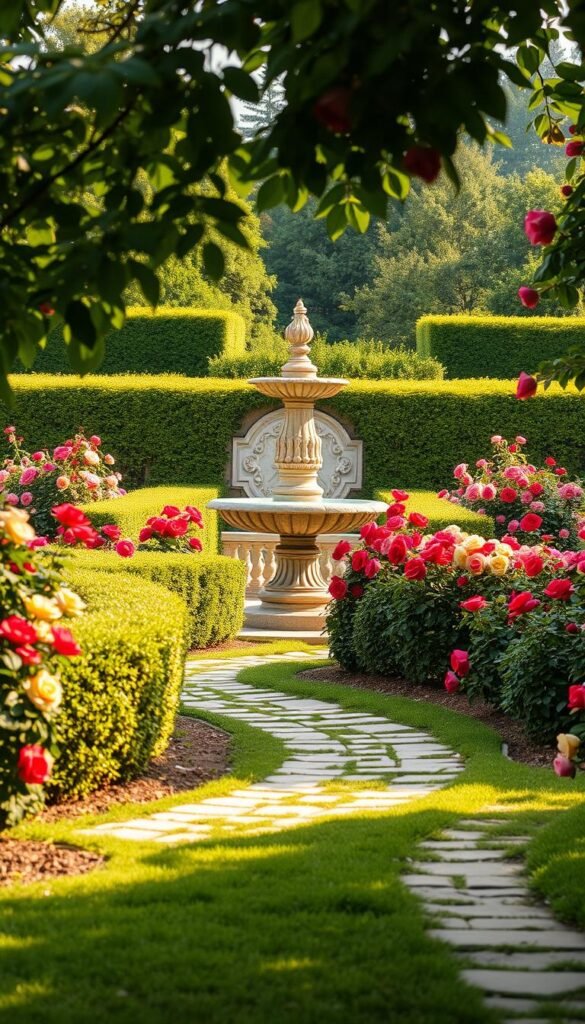Roses have graced gardens for centuries, and it’s easy to see why. Their lush blooms and sweet fragrance turn ordinary spaces into living works of art. Modern growers now enjoy easier care thanks to disease-resistant varieties that flourish in diverse climates.
Whether you’re working with a cozy patio or sprawling backyard, these flowering shrubs adapt beautifully. Start with one standout plant as a focal point, or design an entire landscape featuring arches and decorative accents. The key lies in balancing practicality with creativity.
New hybrid types eliminate the need for constant maintenance, making them perfect for busy homeowners. You’ll find options thriving in containers, narrow side yards, or mixed flower beds. Pair them with complementary perennials for seasonal interest.
What makes these plants truly special is their ability to evolve with your space. As they mature, their structure creates natural elegance that boosts curb appeal. With smart planning, your outdoor area becomes a personal retreat that ages gracefully.
Planning Your Classic Rose Garden
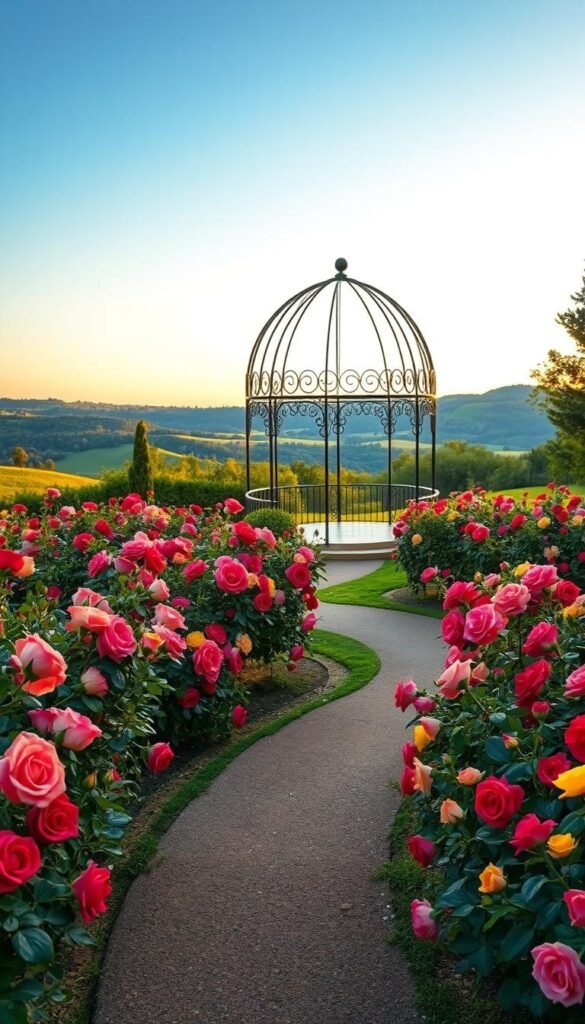
Successful rose cultivation hinges on careful site selection and layout design. Start by identifying areas in your yard that receive 6-8 hours of direct sunlight daily. These sun-loving beauties thrive when bathed in light, which also helps prevent common fungal issues.
Sunlight and Airflow Essentials
Choose spots with steady airflow to keep leaves dry and pests at bay. Avoid low areas where cold air or water pools—roses prefer well-drained soil and room to breathe. Test your soil’s pH (ideally 6.0-6.5) and enrich it with compost for robust growth.
Mapping Your Vision
Sketch beds no wider than 5 feet so you can easily reach plants for pruning. Add winding pathways using gravel or mulch for maintenance access and visual charm. Browse design inspiration to blend symmetry with natural curves, ensuring your layout complements your home’s architecture.
Position beds where you’ll enjoy their fragrance from patios or windows. Pair roses with complementary plants like lavender or catmint to create layered textures. Remember: smart planning today means less work tomorrow.
Understanding Different Rose Varieties
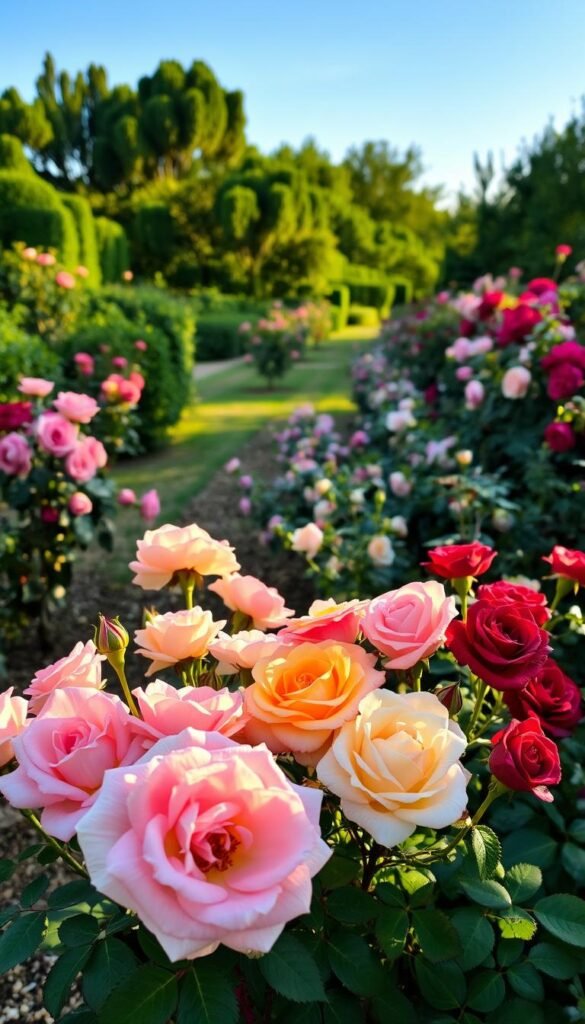
Picking the right roses starts with knowing your options. Modern breeding offers diverse types suited to various spaces and care levels. Let’s explore popular choices that balance beauty with practicality.
Hybrid Teas vs Shrub Roses
Hybrid teas deliver iconic blooms perfect for bouquets, but demand regular care. They need winter protection in colder zones and frequent pruning to maintain their elegant form. Fungal issues can arise without proper airflow.
Shrub roses thrive with minimal fuss. Newer types like Oso Easy® bloom nonstop and shrug off diseases. Their bushy growth fills spaces beautifully without constant trimming. Perfect if you want color without high maintenance.
| Feature | Hybrid Teas | Shrub Roses |
|---|---|---|
| Bloom Size | Large, single stems | Clusters of smaller flowers |
| Maintenance | High (pruning, winter care) | Low |
| Disease Resistance | Moderate | High |
Exploring Climbing and Groundcover Options
Climbing roses transform fences into floral walls. Varieties like ‘New Dawn’ reach 15 feet, ideal for arches. Train them early for best coverage.
Groundcover roses like Drift® series bloom for months with zero deadheading. They’re slope heroes, preventing erosion while adding color. Just plant and enjoy!
Designing the Garden Layout
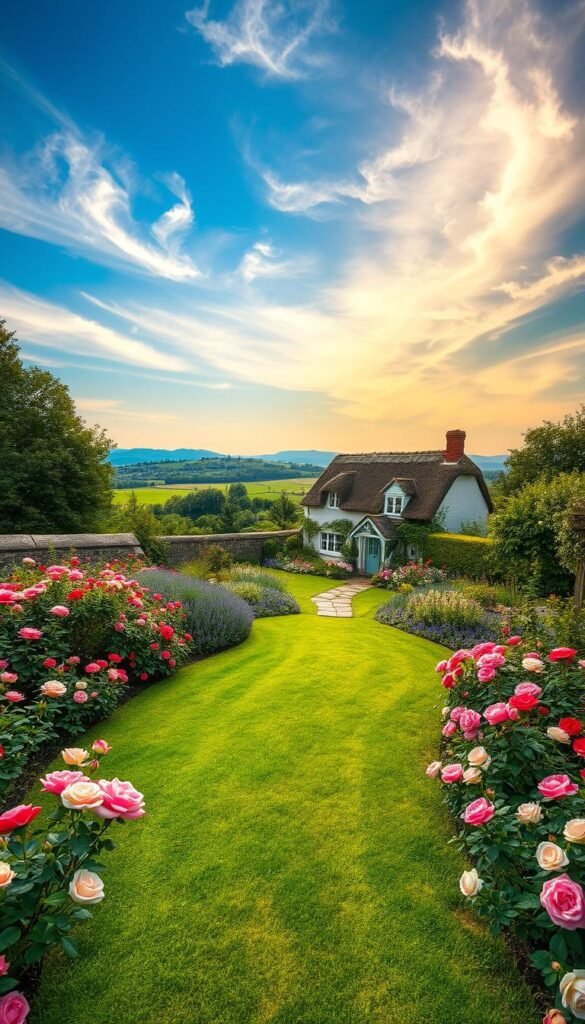
Your outdoor space becomes a canvas when blending structured elegance with wild charm. Choosing between formal precision and cottage-style freedom—or mixing both—lets you craft a space that reflects your personality. Let’s explore how to balance these approaches for maximum impact.
Structured Elegance Meets Natural Charm
Formal layouts thrive on symmetry. Think geometric beds edged with boxwood, where hybrid teas stand like soldiers in straight rows. Add pergolas or stone statues to emphasize order. These designs pair beautifully with modern homes, creating crisp lines that echo architectural details.
For a cottage garden vibe, let plants mingle freely. Shrub roses spill over borders alongside lavender and daisies, creating a tapestry of color. “The best cottage gardens look effortless, as if they’ve grown that way for decades,” notes one landscape designer. This style suits rustic homes, with winding paths inviting exploration.
| Feature | Formal Design | Cottage Style |
|---|---|---|
| Structure | Symmetrical lines | Free-flowing curves |
| Plant Arrangement | Orderly rows | Mixed groupings |
| Key Elements | Hedges, statues | Herbs, perennials |
| Maintenance | High | Moderate |
| Best For | Modern/classic homes | Farmhouse settings |
Blend both worlds by framing loose plantings with neat pathways. Use arches to add vertical interest without strict symmetry. Your space will feel intentional yet inviting—proof that rules are made to be bent.
Preparing Your Garden Soil and Planting Techniques
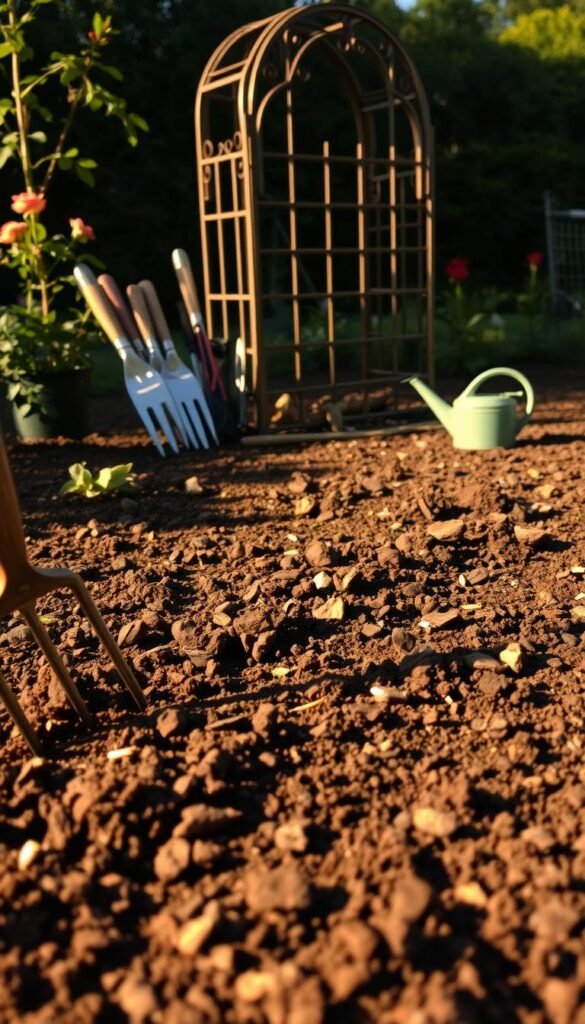
Healthy blooms begin beneath the surface. Giving your plants the right foundation ensures they’ll thrive for years. Let’s dig into the essentials of soil prep and smart planting.
Amending Soil with Organic Matter
Test your soil’s pH first—roses love slightly acidic conditions (6.0-7.0). If your ground is too alkaline, mix in peat moss or sulfur. For heavy clay, blend coarse sand and compost to boost drainage. Well-aged manure works wonders for adding nutrients without burning roots.
In containers? Use quality potting mix and ensure drainage holes. A study by rose-growing experts shows proper soil prevents root rot. Mix perlite into store-bought soil for better airflow.
Proper Plant Spacing and Watering Practices
Dig holes twice as wide as the root ball. This gives roots room to spread. Backfill with amended soil, pressing gently to remove air pockets. Space bushes 3-4 feet apart—crowding invites disease.
Water deeply once or twice weekly instead of daily sprinkles. “Deep soaking trains roots to seek moisture below,” says a master gardener. New plants need consistent moisture, but mature ones prefer thorough drinks. Pair with colorful container gardening for patio-friendly options.
Selecting Companion Plants for Enhanced Beauty
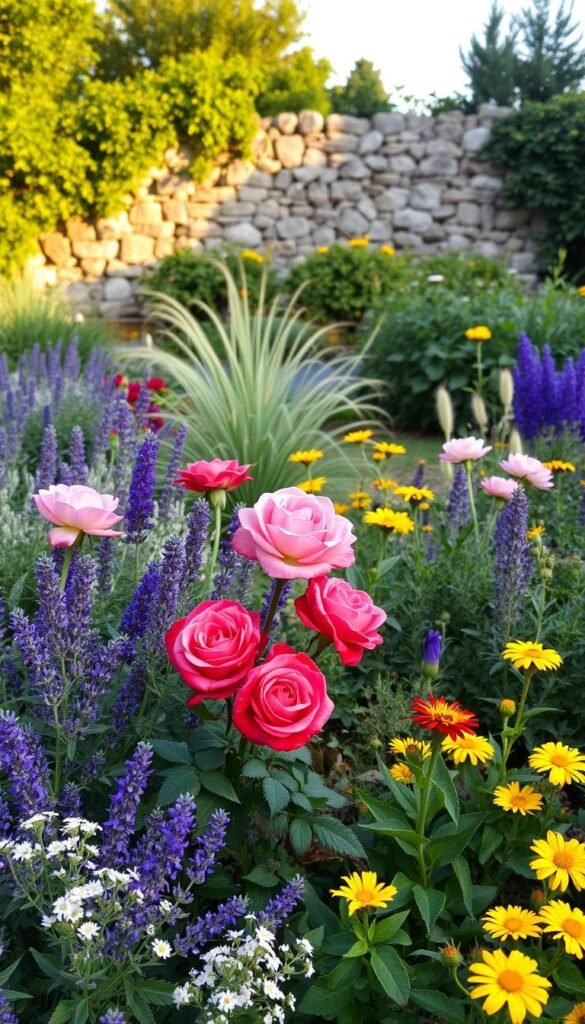
Pairing your roses with the right plants creates a dynamic display that elevates your entire space. Thoughtful combinations boost visual interest while supporting healthy growth through shared sunlight and soil needs.
Nature’s Perfect Partners
Perennials like lavender and salvia work overtime in your beds. Their drought tolerance matches rose care routines, while their spiky shapes contrast beautifully with rounded blooms. Alliums add whimsy with purple puffball flowers that transition to sculptural seed heads.
Harmony Through Contrast
Play with color temperatures for eye-catching combinations. Try apricot roses against blue catmint, or crimson varieties with golden coreopsis. “Lavender’s silvery foliage makes rose colors pop while masking bare stems,” notes California gardener Mia Torres.
| Plant Type | Examples | Benefits | Bloom Period |
|---|---|---|---|
| Perennials | Salvia, Phlox | Structure, pest control | Spring-Fall |
| Annuals | Petunias, Verbena | Continuous color | All season |
| Herbs | Rosemary, Thyme | Fragrance, edging | Summer |
For fragrance layering, mix roses with aromatic herbs. Rosemary’s pine-like scent complements floral notes, while thyme releases fragrance when brushed. These pairings create sensory depth and naturally deter pests.
Incorporating Garden Structures for Visual Impact
Vertical elements elevate your outdoor space from flat to fantastic. Structures like arches and obelisks add dimension while showcasing climbing varieties. They create focal points that guide the eye upward, transforming ordinary areas into immersive experiences.
Architectural Accents That Work Hard
Pergolas turn functional shade into floral artistry. Train climbing roses across their beams—within three seasons, you’ll have a living ceiling of blooms. These structures naturally define seating areas while letting light filter through.
Obelisks offer vertical drama without bulk. Place matching pairs along walkways to frame views. Their slender profiles support rambling roses beautifully, especially in compact front yards. Choose powder-coated steel for longevity.
Pathways With Purpose
Arches make transitions magical. Install one where your lawn meets a vegetable patch or between property zones. As roses cascade overhead, they create fragrant tunnels that change with the seasons.
For quick impact, try DIY trellises against blank walls. They’re perfect for training young climbers while hiding unsightly surfaces. Just ensure supports can handle mature plants’ weight—some varieties reach 20 pounds!
| Structure | Best Use | Key Benefit |
|---|---|---|
| Pergola | Over patios/dining areas | Provides shade + floral display |
| Arbor | Entryways/path transitions | Creates inviting thresholds |
| Obelisk | Small gardens/containers | Adds height without width |
Remember: position structures where you’ll enjoy them daily—near seating spots or along often-used paths. With smart placement, these elements become both artwork and functional supports for your blooms.
Utilizing Vertical Growth for Limited Spaces
Small spaces can’t limit your floral ambitions when you think upward. Vertical growth turns unused surfaces into blooming masterpieces. Fences become living art with strategic planting.
Guiding Climbers for Maximum Impact
Train climbing roses along fences to create natural privacy screens bursting with color. Choose flexible varieties like ‘Zephirine Drouhin’ that adapt to horizontal training. Secure canes loosely with soft ties—tight restraints hinder growth.
Pair roses with clematis for double the drama. The vines’ twining habit weaves through rose stems effortlessly. You’ll enjoy staggered blooms from spring through fall, with clematis flowers accenting rose petals.
Even narrow side yards shine when you utilize vertical space. Guide climbers up drainpipes or lattice panels. This approach adds depth to tight spots while keeping walkways clear. “It’s like hanging a painting that changes weekly,” says urban gardener Tasha Rivera.
Define functional zones by training roses along boundary fences. A floral wall separates dining areas from play spaces naturally. For chain-link eyesores, let vigorous climbers like ‘New Dawn’ create living coverage in two seasons.

